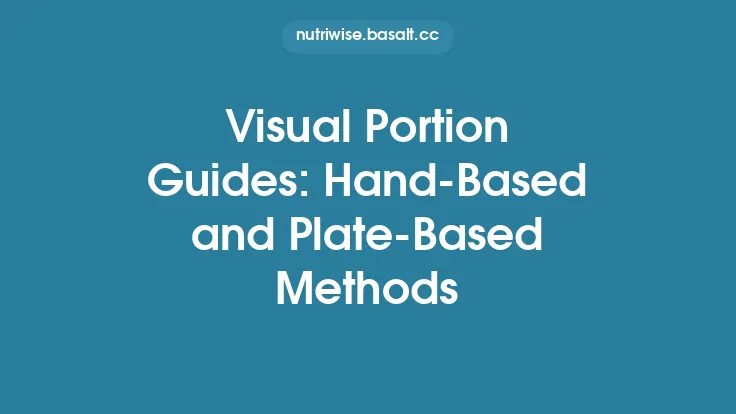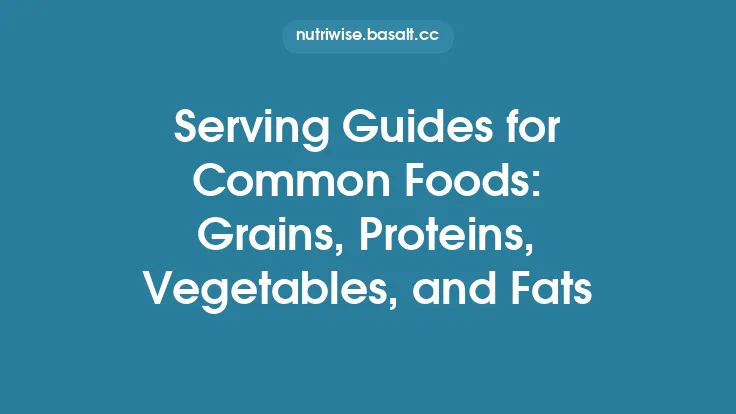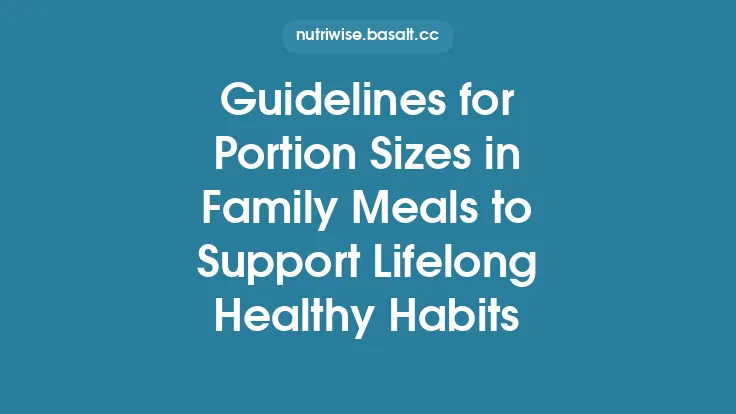When it comes to eating well, the most powerful tool you already have is your own body. By learning to read the size and shape of your hands and the familiar outline of a dinner plate, you can gauge how much you’re putting on your fork without needing a kitchen scale, a nutrition label, or a calculator. Visual portion guides translate abstract nutritional concepts into concrete, everyday cues that are easy to remember and quick to apply—whether you’re cooking at home, grabbing a take‑out box, or eating at a restaurant. Below, we explore the science behind visual estimation, break down the hand‑based and plate‑based methods step by step, and provide practical advice for making these shortcuts reliable parts of your daily routine.
Why Visual Guides Work
Human perception is remarkably adept at judging relative size, especially when the reference objects are familiar. The brain processes visual information about area, volume, and proportion far faster than it can interpret numbers on a label. When you consistently pair a food item with a known visual cue—such as the size of your palm or the division of a plate—your brain builds a mental “template” that can be recalled instantly.
Research on visual perception shows that people are more accurate at estimating portions when they have a concrete reference point rather than an abstract measurement. This is why a hand or a plate, which you see and touch every day, serves as a reliable anchor for portion control. The method also reduces the cognitive load of counting calories or grams, allowing you to focus on the enjoyment of the meal and the signals your body sends.
The Hand Method: A Portable Portion Estimator
Your hands are always within reach, making them an ideal, low‑tech tool for estimating food amounts. The method relies on the natural variations in hand size—your own palm, fist, thumb, and cupped hand each correspond to a different volume range. Below is a quick reference that works for most adults; you can fine‑tune the estimates by comparing a few foods to a kitchen scale once, then rely on the visual cue thereafter.
| Hand Cue | Approximate Volume | Typical Food Types |
|---|---|---|
| Palm (excluding fingers) | 3–4 oz (85–115 g) | Lean meats, fish, tofu, cheese |
| Fist | ½ cup (120 ml) | Cooked grains, starchy vegetables, legumes |
| Cupped Hand | ½ cup (120 ml) | Nuts, seeds, dried fruit, avocado |
| Thumb | 1 tsp (5 ml) | Oils, butter, nut butter, dressings |
| Two‑Finger Pinch | 1 tbsp (15 ml) | Peanut butter, hummus, jam |
How to Use the Hand Method in Real‑Time
- Identify the food category – protein, carbohydrate, or fat.
- Select the appropriate hand cue – e.g., palm for chicken breast, fist for rice.
- Shape your hand – flatten the palm, make a fist, cup your hand, etc.
- Fill the space – scoop or press the food until it matches the outline of your hand.
- Adjust as needed – if the portion looks too large or small compared with the cue, make a quick visual correction.
Because hand size varies, the method is inherently personalized. A larger hand will naturally hold a larger portion, which aligns with the principle that energy needs often correlate with body size. If you share the method with a partner, each of you should use your own hands for estimation.
Step‑by‑Step Hand Technique for Different Food Types
Protein (Meat, Fish, Poultry, Plant‑Based Alternatives)
- Palm Rule: Lay your palm flat, fingers together, and place the protein on top. The thickness of the meat should not exceed the height of your palm. For fillets or tofu blocks, aim for a slab that covers the entire palm surface.
Starches and Whole Grains (Rice, Pasta, Quinoa, Potatoes)
- Fist Rule: Form a relaxed fist and fill it with the cooked grain or diced potatoes. The volume should be roughly half a cup. For long‑grain rice, flatten the fist slightly to accommodate the shape.
Vegetables (Raw or Cooked)
- Two‑Hand Method: Use both hands to create a “V” shape, placing the vegetables between them. This works well for leafy greens, broccoli florets, or mixed stir‑fry vegetables. The goal is to fill the space without compressing the veggies, preserving their natural volume.
Healthy Fats (Nuts, Seeds, Avocado, Oils)
- Cupped Hand or Thumb: For solid fats like nuts, cup your hand and fill it to the level of a half‑cup. For liquid fats, use the thumb tip to gauge a teaspoon of oil or butter.
Snacks and Condiments
- Pinch or Thumb: A pinch of cheese, a tablespoon of salsa, or a teaspoon of honey can be measured using the tip of your thumb or a two‑finger pinch.
The Plate Method: Turning Your Dinner Plate into a Nutritional Blueprint
While the hand method excels for quick, on‑the‑go estimations, the plate method provides a broader visual framework for balanced meals. By dividing a standard dinner plate (approximately 9–10 inches in diameter) into distinct zones, you create a quick visual checklist that encourages variety and proportion without explicit numbers.
Basic Plate Layout
- Half the Plate – Non‑Starchy Vegetables
Fill the larger half with colorful, fiber‑rich vegetables. The visual cue is simple: the plate should look at least 50 % covered by greens, peppers, carrots, or similar items.
- One‑Quarter of the Plate – Protein
Reserve a quarter for protein sources. This can be a palm‑sized portion of meat, fish, tofu, or legumes. The visual cue is the same as the hand method’s palm rule, but placed within the plate’s quadrant.
- One‑Quarter of the Plate – Starches or Whole Grains
The remaining quarter holds cooked grains, starchy vegetables, or legumes. Visualize a fist‑sized mound in this space.
- Optional Side – Healthy Fat
A small circle or drizzle (thumb‑size) of oil, nuts, or avocado can be added on the side of the plate.
Visual Consistency Across Plate Types
- Standard Dinner Plate (9–10 in) – Works best for the classic ½‑¼‑¼ division.
- Smaller Plates (7–8 in) – Naturally reduce portion sizes; the same visual zones apply, but the absolute volume is smaller.
- Bowl Meals (e.g., soups, grain bowls) – Imagine a “virtual plate” inside the bowl: fill the bottom half with vegetables, then add protein and starch in the upper half.
Customizing the Plate Method for Varied Meal Contexts
The plate method is flexible enough to accommodate different cuisines and eating occasions while preserving its visual simplicity.
| Situation | Adjustment | Visual Cue |
|---|---|---|
| Breakfast | Replace the starch quarter with a whole‑grain toast or oatmeal portion; keep half the plate for fruit or veg. | Visualize a toast slice covering the same area as a quarter of the plate. |
| Lunch Box | Use a divided container that mimics the plate zones; each compartment acts as a visual cue. | The larger compartment (≈½) holds veggies; the two smaller compartments (≈¼ each) hold protein and carbs. |
| Restaurant Dining | When plates are larger, mentally shrink the visual zones to the ½‑¼‑¼ pattern; discard excess or ask for a to‑go box. | Imagine a “plate within a plate” and fill only that inner area. |
| Family Style | Serve communal dishes, then plate your own portions using the hand method to respect the plate zones. | Use your palm and fist as personal guides while the overall spread follows the plate layout. |
Combining Hand and Plate Strategies for Flexibility
The two visual systems complement each other. When you have a plate in front of you, use the plate zones to set the overall balance, then fine‑tune each component with the hand method. For example:
- Step 1: Fill half the plate with mixed vegetables.
- Step 2: Place a palm‑sized piece of grilled salmon on the protein quarter.
- Step 3: Add a fist‑sized scoop of quinoa to the starch quarter.
- Step 4: Drizzle a thumb‑sized amount of olive oil over the veggies.
This layered approach reduces the chance of over‑ or under‑estimating any single component, especially when the food’s shape makes visual judgment tricky (e.g., fluffy rice vs. compacted quinoa).
Practical Tips for Consistency and Accuracy
- Practice with a Scale Once – Measure a few typical foods with a kitchen scale, then compare the weight to the hand cue you used. This calibration step sharpens your internal reference.
- Standardize Your Plate – Keep a single dinner plate for most meals; the brain adapts faster to a consistent visual frame.
- Mind the Thickness – For proteins, the palm rule refers to the surface area, not the height. A thin fillet that covers the palm is acceptable; a thick steak should be trimmed to match the palm’s thickness.
- Use Light‑Colored Plates – Contrasting colors make it easier to see how much of the plate is covered, especially with green vegetables.
- Account for Cooking Shrinkage – Some foods (e.g., rice) expand when cooked. Estimate the raw portion using the hand cue, then apply the same visual cue after cooking.
- Stay Hydrated – A glass of water occupies visual space too; a standard 8‑oz glass can be visualized as a small cylinder that fits comfortably beside the plate.
Common Pitfalls and How to Avoid Them
| Pitfall | Why It Happens | Quick Fix |
|---|---|---|
| Over‑filling the palm with fatty meats | Fat adds volume without much visual bulk. | Use the thumb rule for added fats (e.g., butter, cheese) and keep the protein palm lean. |
| Assuming all plates are the same size | Restaurant plates can be 30 % larger. | Mentally shrink the visual zones or ask for a smaller plate. |
| Counting “half a plate” of veggies but actually covering only a quarter | Visual illusion caused by dense, dark greens. | Lightly toss veggies with a splash of dressing to increase apparent volume. |
| Using the fist rule for fluffy foods like rice, leading to over‑estimation | Air pockets inflate volume. | Press the fist gently to flatten the rice, matching the true half‑cup volume. |
| Neglecting the side of the plate for sauces | Sauces can add hidden calories. | Use the thumb rule for sauces and drizzle sparingly. |
Integrating Visual Guides into Everyday Meal Planning
- Meal Prep with Hand Cues – When batch‑cooking, portion out proteins and carbs into containers using your palm and fist before sealing them. This creates a ready‑to‑go visual library.
- Grocery Shopping – Visualize the hand cues while selecting produce: a handful of berries ≈ a cupped hand, a bunch of carrots ≈ two palms.
- Dining Out – Before the server places the dish, picture a plate in your mind and mentally allocate the zones as the food arrives. If the portion looks too large, ask for a side box early.
- Family Education – Teach children the “palm‑size chicken” and “half‑plate veggies” rules; they quickly adopt the visual language and develop intuitive portion awareness.
Conclusion: Making Visual Portion Guides a Habit
Visual portion guides translate the abstract language of nutrition into the concrete, everyday objects you already use—your hands and your plate. By consistently applying the hand method for quick, on‑the‑go estimations and the plate method for balanced meals, you gain a reliable, low‑effort system for controlling intake without the need for scales, calculators, or detailed serving charts. The key to lasting success lies in practice, occasional calibration, and a willingness to adjust the visual cues to your own body size and lifestyle. Once these visual habits become second nature, you’ll find that healthy eating feels less like a chore and more like an intuitive, enjoyable part of daily life.





